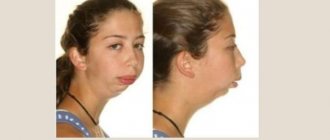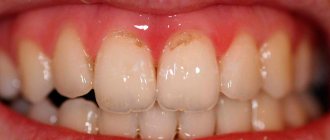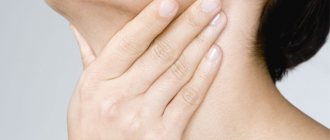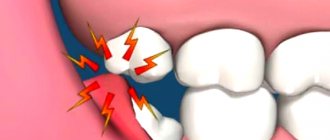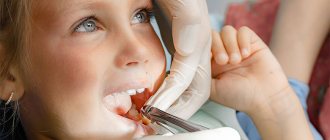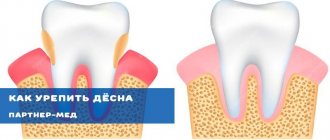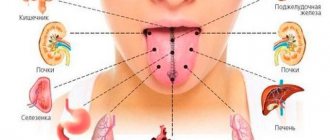Adenoviruses and infectious mononucleosis
If white pimples appear in the throat and tonsils, this may indicate the presence of a viral infection.
Adenoviruses infect the outer tissues of the eyes and throat, particularly the tonsils. In this case, the tonsils swell, increase in size, their mucous membranes turn red, become covered with a rash and a whitish coating. If white pimples appear in the throat of an adult, this may indicate the development of mononucleosis. This is a very common infectious disease that develops against the background of the activity of the fourth type of herpes virus.
Mononucleosis is also accompanied by damage to the throat. First, small pimples appear on the tissues, which over time turn into ulcers. The tonsils are covered with a yellowish and grayish coating. The mucous membranes swell greatly (sometimes so much that they completely cover the pharynx). In addition, there is an increase in the submandibular and cervical lymph nodes, as a result of which the neck swells and the face takes on a puffy appearance. An undulating fever occurs: the temperature either rises sharply (sometimes up to 40-41 degrees), then returns to normal. The patient requires hospitalization and adequate therapy.
Types of diseases
There are many throat diseases that have such common symptoms as a rash of white pimples in the throat, pustules. This occurs with follicular, herpetic, sore throats. The history of follicular tonsillitis is an inflammatory process of bacterial origin. During a medical examination of the mucous membrane of the throat, the follicles or lymph nodes look like pimples. Abscesses with follicular sore throat rarely appear. Pimples are localized on the back wall of the throat. They are all white, about the size of a pin's head. The course of the disease is associated with fever, intoxication and headache. There is acute pain in the throat, redness of the mucous membrane, enlarged tonsils, blisters, and ulcers. With angina, complications may arise: rheumatism, disruption of the heart muscle, renal colic.
Inflammatory diseases can provoke allergic reactions and attacks of bronchial asthma. With herpetic sore throats, pustules appear in the form of pimples on the palate and back wall of the pharynx; they are called vesicles. The cause of the disease is enteroviruses. There are forms of sore throat that appear due to staphylococcus and streptococcus. Then pimples appear on the throat.
Another disease with similar symptoms is enteroviral pharyngitis. Transmitted by airborne droplets. The disease causes high fever, delays in swallowing, vomiting, and granules on the mucous membranes of the throat. Swallowing food is very difficult. The entire back wall of the throat is covered with small pimples. Most often, children suffer from antiviral pharyngitis, less often adults.
A throat abscess is a purulent disease. An abscess forms on the tonsils, pharynx and palatine arches after suffering purulent otitis or tonsillitis. The causative agents of abscesses are: streptococci, Klebsiella and Escherichia coli.
Abscesses with pharyngitis occur as a complication of acute respiratory viral infections or colds. When the disease occurs, the throat and tonsils are covered with pimples and watery blisters. Pustules form on these pimples. After treatment they disappear, but in some cases the tonsils remain enlarged for several weeks after the illness. If, despite treatment, symptoms persist, then you should consult a doctor. This may be due to chronic granulosa pharyngitis. The formation of ulcers is promoted by reduced immunity, lack of vitamins and microelements, constant hypothermia, and bacterial infections. Purulent processes are accompanied by fever, pain, increased salivation and bad breath. On the outside of the neck, at the site of the internal lesion, the skin turns red and swelling forms.
With stomatitis, the mucous membranes of the mouth are affected. Yellow and gray erosive wounds form on the gums, the inside of the lips and the soft palate. Single and grouped foci of the disease appear, which are accompanied by an increase in temperature. The cause of the disease may be the herpes virus. A sign of the disease are bubbles in the throat. They occur in acute and severe forms of the disease. The course of the disease is similar to all viral diseases: fever, weakness and malaise.
Pharyngitis
Pharyngitis often develops with influenza, ARVI, and adenovirus infection. The acute course is accompanied by a runny nose, cough, and pain when swallowing.
The causative agent is often also a bacterium - streptococcus or staphylococcus. In this case, the inner walls of the pharynx become inflamed. For chronic pharyngitis in adults, there are 2 forms:
- Hypertrophy of the surface layer of the larynx is manifested by a constant accumulation of mucus, which causes coughing.
- With atrophic pharyngitis, the walls of the pharynx are dry, as if covered with varnish. Crusts form on the inner wall, creating a feeling of a foreign body and discomfort in the throat.
In childhood, pharyngitis manifests itself as pimples on the back of the throat in the form of red dots and blisters against the background of a red, swollen mucous membrane.
Pain in the throat sometimes radiates to the ears.
By the way! Pharyngitis is more common in children who spend most of their time indoors with excessively warm, dry air.
The chronic form of the disease often occurs with sinusitis and tonsillitis. Therefore, during the treatment period, first of all, these persistent foci of infection are eliminated. Pay attention to the rehabilitation of the paranasal sinuses.
The treatment of choice for bacterial pharyngitis is antibiotics. In complex therapy, gargling with saline and soda solutions is used. Irrigation with Inhalipt and lubrication with oil-alcohol tincture of propolis are recommended.
For viral pharyngitis, limit yourself to gargling with medicinal herbs and soda solution. Antipyretic and painkillers are used. Walking in the fresh air in calm weather is necessary for the respiratory tract.
Pimples in the throat as symptoms of diseases: causes, diagnosis, treatment methods
Pimples in the throat usually form due to a viral, bacterial or fungal infection. Each disease is characterized by a different shape, color and location of rashes on the mucous membranes.
By the appearance of pimples, doctors determine a childhood infection, stomatitis or thrush. At the diagnostic stage, dangerous specific diseases may be identified.
Scarlet fever
The causative agent of this infectious disease is hemolytic streptococcus, which causes inflammation of the oral mucosa. Infection occurs 2–3 days after contact with a patient with tonsillitis, pharyngitis, or a carrier of the bacteria.
The first signs of scarlet fever are fever and sore throat. The next day, a rash appears on the cheeks, folds of the arms and legs, and sides of the body. A feature of the skin lesion is a white nasolabial triangle, untouched by the rash.
Note! On the second or fourth day of illness, the patient’s tongue becomes “crimson.” Its papillae enlarge and become bright red, giving the tongue a grainy appearance.
The tonsils are inflamed, covered with purulent plaque, and painful when swallowing.
The main treatment for scarlet fever is antibiotics - Amoxiclav, Phenoxymethylpenicillin, Ampicillin for 7-10 days. The infection is usually mild. But rapid improvement is not a reason to discontinue the drug.
Streptococcus is destroyed in the body only with a full course of treatment. Otherwise, the patient will be its carrier, posing a danger to the family. Additionally, B vitamins and ascorbic acid are prescribed.
Stomatitis
The causative agent of stomatitis is the herpes virus, which often infects children under 3 years of age. Inflammation of the mucous membrane occurs with sore throat while eating. Signs of stomatitis;
- hyperemia of the pharyngeal walls;
- spots that differ in color and shape, covered with a yellowish coating;
- ulcers appear on the inner walls of the cheeks, gums and back wall of the larynx, surrounded by a halo;
- formation of “jammed” cracks in the corners of the mouth.
Antiviral drugs are used to treat stomatitis. Both special agents and herbal preparations are used as immunostimulants - Chinese lemongrass, Echinacea.
Sebidin, Septolete, Faringosept relieve throat pain. For oral candidiasis, an effective Candida solution is widely used.
Treatment
In addition to special therapy prescribed by a doctor for each disease, traditional methods of treatment are used.
The following products are recommended for mouth rinsing for candidiasis:
- juice of aloe or related Kalanchoe, diluted with water;
- soda or saline solution in a proportion of 1 tsp. for 200 ml of boiled water;
- infusion of a mixture of dried herbs - chamomile, mint and eucalyptus. To prepare the solution in a water bath, take 1 tbsp. l. dry collection in a glass of boiled water, infuse for 15 minutes;
- After rinsing, doctors advise dissolving a spoonful of honey in your mouth.
To strengthen the local immunity of the oral mucosa, herbal teas with lemon, honey, linden, and raspberries are useful. It is useful to take a drink made from rose hips.
For sore throat, beet juice relieves sore throat. Propolis helps, which is usually chewed several times a day. Gargling with infusions of chamomile, eucalyptus, and sage is widely used.
Diagnostics
A doctor can suspect an infection based on the characteristic signs of the disease. In addition to examining the throat with mirrors, the ENT doctor needs a general blood test to determine the presence of inflammation or allergies.
When diagnosing a sore throat, a swab or swab is sometimes taken from the nasopharynx to determine the virus.
The main way to detect a fungal infection is a bacteriological analysis of a smear from the nasopharynx or scraping from plaque. After examining the material under a microscope, Candida albicans fungi are usually detected.
Pimples in the throat with a coating after examination sometimes turn out to be syphilis, infectious mononucleosis, gonorrhea or diphtheria. Therefore, if any rash occurs in the mouth, it is best to consult a doctor. Home treatments are used after diagnosis.
Angina
Rashes in the mouth appear with various types of acute tonsillitis after contact with a sick person. Herpangina usually affects children between 2 and 5 years of age. Sometimes the disease occurs in infants.
The herpes virus, penetrating through the respiratory tract, causes pimples to appear in the child’s throat. At the beginning of the disease, the papules are dry. Gradually filling with liquid, they take the form of bubbles.
They spread to the tonsils and soft palate, accompanied by pain when swallowing and enlarged cervical lymph nodes. The rash lasts in the throat for up to 7 days and may appear on the body.
No specific treatment is required. Local preparations are used to irrigate the oral cavity - Ingallipt spray, Hexoral. Antihistamines Claritin, Erius, Peritol are used.
By the way! Suprastin is not recommended to be taken as it dries out the mucous membranes of the respiratory tract.
Drinking plenty of fluids is prescribed. Salty and spicy foods are excluded from the diet. A warm semi-liquid diet is indicated.
Bacterial tonsillitis is caused by pneumococcus, streptococcus, and less commonly staphylococcus. A pimple in the throat in the form of a white dot indicates a purulent process.
With follicular tonsillitis, many such foci the size of a pinhead form on the tonsils. If not treated correctly, these rashes merge to form an abscess.
Signs of purulent sore throat:
- white pimples in the throat on the tonsils;
- the tonsils swell, hypertrophy to such an extent that they interfere with air access;
- elevated temperature 38–39.0 °C;
- severe weakness;
- whitish coating on the tongue;
- sore throat;
- Pain in the throat worsens even when swallowing saliva.
Mostly children of preschool age and adults 35–40 years old suffer from tonsillitis. The infection is complicated by rheumatism and pyelonephritis. May spread to the bronchi and lungs.
Therapy for a bacterial form of sore throat cannot be done without the use of broad-spectrum antibiotics if a bacterial infection has occurred - Amoxiclav Solutab, Flemoxin Solutab, Sumamed (Azithromycin). Antiviral tablets are prescribed - Acyclovir, Tiloron. It is also recommended to irrigate the throat with Interferon and do disinfectant rinses.
The course of treatment lasts at least 10 days. It should not be stopped at the first symptoms of improvement. This leads to bacterial resistance to antibiotics.
When the temperature rises, antipyretics are used - Ibuprofen, Paracetamol. For children, these products are available in the form of syrup and suppositories.
In complex treatment, gargling with soda and salt solution is mandatory. Frequent rinsing removes bacteria from the surface of the tonsils along with plaque and purulent plugs.
Thanks to the procedure, throat sprays Orasept, Ingallipt, Hexoral, Stopangin effectively suppress the infection.
Pimples on the back wall - reasons, what medications to treat
Healthy mucous membranes of the mouth and throat have a smooth surface and a uniform pink color. Pimples and purulent rashes in the throat are symptoms of a variety of diseases. Formations on the mucous membrane usually cause pain, so it is impossible not to notice them.
But in some cases, the rash does not cause discomfort at all. What diseases are signs of pimples and blisters in the throat?
Causes of rashes in the throat
In normal condition, the mucous membrane of the throat is colored light pink and has no dents or bumps.
Pathological formations on the back wall of the throat can be easily detected even by a person without medical knowledge. Usually the rashes are accompanied by pain and discomfort, but sometimes they do not cause discomfort.
Below are the diseases that are the most common causes of pathological changes in the throat.
Methods for treating acne on the back of the throat
Before treating pimples in the throat, you need to find out the cause of their occurrence.
Only a medical specialist can make an accurate diagnosis, so the sick person must go to the doctor and get tested.
To determine the disease, it is usually enough for the doctor to examine the patient’s mucous membranes of the throat. Sometimes a general blood test is prescribed to detect an infection or allergic process in the body.
To confirm the presence of the virus, your doctor may take a swab of your tonsils and pharynx. Based on the results of the examination and tests, the doctor prescribes the optimal therapy. How to treat pimples in the throat?
- For a bacterial infection, antibiotics should be taken. Antibiotic medications are used for pharyngitis.
- For viral infections, anti-inflammatory medications are prescribed.
- For fungal infections, antimycotic drugs are prescribed.
- For an abscess, surgical intervention is used in most cases. The ulcers are removed, and after the operation it is necessary to use detoxification and antibiotic medications.
Additionally, the doctor may recommend that the patient gargle with a saline, iodine or soda solution, a decoction of calendula or chamomile, or Furacilin. Rinsing should be done every two hours.
During the procedure, a sick person should try to absorb the affected area of the throat as much as possible with the medicinal solution. It is useful to do inhalations based on infusions of medicinal plants: sage, eucalyptus, aloe, linden.
A sick person should remain in bed, take vitamin complexes, eat only soft and light foods that do not irritate the throat, and drink plenty of warm liquids. To get rid of pathological formations in the throat, modern clinics offer ultraviolet and laser therapy and other physiotherapeutic measures.
Preventive measures
To avoid throat problems, you must often be in the fresh air. When a person inhales abundantly, the mucous membranes of his respiratory tract are moistened and well coated with saliva, which has an antibacterial effect.
To maintain health, you need to drink enough water, eat a quality and balanced diet, and take vitamins. You should definitely give up bad habits, especially smoking, which causes severe damage to the mucous membranes of the pharynx.
It is useful to harden yourself, adhere to a certain daily routine, and take a contrast shower. It is not advisable to use antibiotics frequently. These medications are addictive.
Symptoms
It is painful for a person with such a problem to swallow. The formations are felt and sometimes hurt. This trouble is invisible, even when a person is talking or singing, however, if you look closely into your mouth, you can easily detect bright red problem areas.
Sometimes the formations itch. It is worth paying attention to the symptoms, since there are a number of diseases in which such a nuisance occurs.
And the sensations in various diseases are similar in some ways, but different in others. To get a complete picture of the problem, it is better to write down the symptoms from the very beginning and, if possible, take photos.
Pimples in the back of the throat treatment
Banal hypothermia and cold air can cause the appearance of a red throat. Also eating excessively cold, hot or spicy foods. Allergic reactions to external irritants.
A dry microclimate in the room, swallowing snow in winter (applies to children), and eating solid foods that can scratch the mucous membrane and provoke an inflammatory process can cause tickling and coughing.
//www..com/watch?v=ZgqjCEvULJg
viruses that cause pharyngitis in 70% of cases, this will indicate the initial stage of development of the disease; bacteria, when streptococci, Haemophilus influenzae, mycoplasma penetrate the body, while the microflora in the nasopharynx, where pathogenic microorganisms live, is disrupted; Candida fungus, cause a chronic stage of the disease in children with weakened immune systems.
Why does a child's throat turn red?
A red back wall of a child’s throat indicates an inflammatory process, especially if the baby has difficulty swallowing and has a sore throat. In this case, you need to approach the healing of the body fully, using antiviral, antibacterial, and immunomodulatory agents.
If there are also red pimples on the back of the throat, this indicates that the inflammation is of a bacterial nature, a rash is formed, white or brown pustules.
Colds and runny nose
Red spots on the back of the throat may indicate the occurrence of mucus, which flows into the throat and causes an inflammatory process. Additionally, the child develops a hoarse voice, cough, and sputum leaving the body.
To stop this process, it is necessary to thoroughly rinse the nasopharynx with a water-salt solution, take cough softeners, followed by expectoration of sputum.
In case of a bacterial runny nose, you need to carry out antibacterial rinsing with Miramistin, inhalation with Decasan or mineral water. With the right approach, this symptom can be completely eliminated in a few days (in the absence of high fever).
Article on the topic - how to rinse with saline solution.
Infections
If your throat hurts and the back wall of your throat is red, then you can safely talk about an infection. It is the mucous membrane of the throat that takes the “blows” of a viral or bacterial attack.
If the infection is viral, then pathogenic bacteria destroy the outer epithelium, creating a favorable environment for microbes to penetrate deep into the tissue, and the integrity of the membrane is compromised.
Treating viral infections with antibiotics is ineffective; antiviral agents and drugs are needed to maintain the body's immune flora, for example, Interferon. But if pus forms on the back wall of the throat, it is necessary to use antibiotics and perform antimicrobial irrigation with chlorophyllipt.
Tonsils
The tonsils are located in the upper part of the larynx, and antibodies are released through their pores into the pharyngeal mucosa. Inflamed almonds are called adenomas; when they enlarge, nasal breathing becomes more difficult, pimples may appear on the back wall of the throat, and a lingering runny nose appears.
It is recommended to rinse the nasal passages with medicinal decoctions or saline solution; for this purpose, you can use an oil- or water-based inhaler.
Teeth cutting
During teething, a slight fever, cough, and runny nose may appear, resulting in a red throat and increased salivation.
During this period, it is important to prevent the addition of a secondary infection, and therefore you need to actively gargle and rinse your nose with saline solutions
Diphtheria
This is an infectious disease. The pathogen is transmitted to a healthy person by airborne droplets. Diphtheria is an inflammatory process that involves the mucous membranes of the nasopharynx and oropharynx, as well as the organs of the nervous, cardiovascular and excretory systems.
Clinical manifestations and their severity directly depend on the severity of the disease. Common symptoms include the following:
- Swelling of the mucous membrane.
- Pimples in the throat, covered with a film.
- Hoarseness of voice.
- Severe pain in the throat.
- Enlarged lymph nodes. Edema also forms around them. In such cases, doctors use the term “bull neck”.
- Too frequent or, on the contrary, difficulty breathing.
- Nasal discharge.
- Chills.
- Fever.
- A state of general malaise.
Diphtheria is a dangerous disease that has many forms. Some of them can be fatal. In addition, serious complications often develop as the disease progresses. Moreover, they can occur both during the course of the disease and several months after complete recovery.
The most likely consequences of diphtheria:
- Myocarditis.
- Damage to the adrenal glands.
- DIC syndrome.
- Respiratory failure.
- Nephrosis of a toxic nature.
- Heart failure.
- Pneumonia.
- Otitis.
- Infectious-toxic shock.
- Peritonsillar abscess.
Treatment of the disease is carried out exclusively in a hospital setting. Immediately after confirmation of the diagnosis, the patient is administered antitoxic serum intravenously or intramuscularly. In addition, taking antibacterial drugs is indicated. Most often, doctors prescribe the following drugs: Erythromycin, Ampiox, Tetracycline, Ampicillin, Penicillin.
In addition, it is important to reduce the degree of intoxication of the body. For this purpose, the administration of a potassium mixture, polyionic solutions and glucocorticoids is prescribed
In some cases, plasmapheresis is performed.
Traditional methods of treatment
Traditional medicine recipes have always been and remain an effective method of combating viral and colds, including pimples in the throat.
At the first signs of illness, you can prepare a solution for gargling at home. To do this you will need a teaspoon of butter, ½ teaspoon of soda and the same amount of ginger powder. Mix all ingredients with boiled milk (100 ml). Rinse your throat well and then eat a tablespoon of honey. At the same time, you should not immediately swallow honey; you need to keep it in your mouth for as long as possible.
Lemon
Lemon is a good remedy for strengthening the immune system, which is actively used for colds. The simplest and most effective remedy is lemon tea.
But not everyone knows that the vitamin C contained in lemon is destroyed under the influence of high temperatures, so it is important to throw the lemon into warm, not hot water.
It is also useful to pour warm (not hot) boiled water over the raspberries and let them brew for a while. Such teas and infusions can be drunk in any quantity; they remove toxins from the body well.
Tea mushroom
Kombucha is a good remedy for relieving pain due to inflammatory processes. You should gargle with the kombucha solution throughout the day. After rinsing, a noticeable improvement occurs already on the 3rd day. The only drawback of this method is the unavailability of kombucha. In this case, it can be replaced with slightly acidified beet juice.
Inhalations
For colds and viral diseases, inhalations of medicinal mint and chamomile help well. 1 tablespoon of herbs is poured with boiled water. To obtain the maximum effect, inhalations must be carried out at least 5 times a day, lasting 20 minutes. For complete recovery, inhalations of the throat and nose are indicated. It is also recommended to use additional treatment methods:
- mustard plasters,
- keeping your feet above the steam,
- foot baths.
It must be remembered that the use of all these procedures must be agreed with a doctor; starting treatment on your own is dangerous, because at a temperature, for example, it is strictly forbidden to carry out inhalations and steam your feet.
Yoga
This method of treatment will not be understandable to everyone, but those who have encountered yoga in their lives should know about a healing remedy for colds, which is called “lion pose.” This exercise helps blood flow to the throat, causing inflammation and pain to disappear. Bubbles in the throat, if any, will also disappear quickly.
This exercise is done like this:
- the patient should sit comfortably,
- lean on the back of the chair,
- open your mouth wide,
- try to stick your tongue out as far as possible.
At the same time, the neck muscles are maximally tense. To do this correctly, you need to imagine a lion that spreads its fingers, bends its paws at the elbows and opens its eyes wide
Here it is important to portray the same aggression, as a result of which the patient will feel an incredible surge of strength. It is recommended to stay in this position longer; for maximum results it must be performed at least 7 times a day.
Moreover, it does not require excessive effort.
Candidiasis
The most common cause of candidiasis is decreased immunity. Therefore, thrush often occurs in the mouth of infants. Thrush is characterized by pimples in the throat, covered with a white cheesy coating. The spots are localized on the tongue, behind the arches, tonsils and soft palate.
Signs of thrush:
- pain and dryness in the throat;
- itching and burning;
- tonsil hypertrophy;
- redness of the throat;
- elevated temperature is observed mainly in children;
- decreased appetite.
Untreated thrush becomes more complicated. Ulcers appear in the mouth and fester. The infection spreads to the larynx. Yeast-like fungi Candida are able to penetrate the digestive system.
With the bloodstream they can spread throughout the body, leading a person to sepsis with a fatal outcome.
During treatment, systemic antifungal drugs are prescribed - Fluconazole, Mycostatin, Fucis, Itraconazole. Medicines are prescribed in courses. The doctor selects medications based on the results of the smear, taking into account the severity of the infection.
Gargles with boric acid and oak infusion are prescribed. The oral cavity is lubricated with Lugol's solution, Fukortsin, sea buckthorn oil and antifungal creams. Ultraviolet and laser rays are used in complex treatment.
Allergy
The symptoms of allergies are similar to colds. It occurs not only in spring and autumn, but at any time of the year. Inflammation develops in the respiratory tract in response to the ingress of an allergen - plant pollen, animal hair.
Allergy symptoms vary depending on the affected area:
- With pharyngitis, redness of the palate and uvula is observed. Severe tissue swelling creates the sensation of a lump in the throat;
- The signs of tracheitis and laryngitis are similar - cough, sore throat, hoarseness. The appearance of hives all over the body is typical.
There is a burning sensation in the eyes and a runny nose. The main danger of allergic inflammation of the respiratory tract is shortness of breath, spasm of the larynx, up to an attack of suffocation during Quincke's edema.
Without treatment, the disease becomes complicated by bronchial asthma or takes a chronic form. A set of measures is aimed at correcting immunity, improving breathing, and preventing relapse of the disease.
Antihistamines Claritin, Tavegil, Erius are used. If necessary, doctors prescribe glucocorticoids.
Special agents are used to stimulate the immune system. Herbal preparations that make breathing easier are also recommended.
Stomatitis
The causative agent of stomatitis is the herpes virus, which often infects children under 3 years of age. Inflammation of the mucous membrane occurs with sore throat while eating. Signs of stomatitis;
- hyperemia of the pharyngeal walls;
- spots that differ in color and shape, covered with a yellowish coating;
- ulcers appear on the inner walls of the cheeks, gums and back wall of the larynx, surrounded by a halo;
- formation of “jammed” cracks in the corners of the mouth.
Antiviral drugs are used to treat stomatitis. Both special agents and herbal preparations are used as immunostimulants - Chinese lemongrass, Echinacea.
Sebidin, Septolete, Faringosept relieve throat pain. For oral candidiasis, an effective Candida solution is widely used.
Causes
The causes of pimples in the throat are associated with diseases in various fields of medicine. Most often, pimples on the throat manifest as infections of the ENT organs. For each pathology, the rashes differ in color, shape, location and accompanying general symptoms.
Pimples in the throat indicate that it may be an inflammation of the mucous membranes of the mouth. Dentists deal with this problem.
All kinds of spots and ulcers of the pharynx appear as a result of childhood infections. Based on the type of rash, doctors determine measles, diphtheria, and scarlet fever.
Prevention
Compliance with preventive measures will help to avoid infectious diseases, and with them, pimples in the throat.
Since the main cause of colds is decreased immunity, prevention should be based on ways to strengthen it. To do this you need:
- spend as much time in fresh and cool air as possible,
- drink more fluids, this prevents overdrying of the mucous membranes and dehydration of the body,
- pierce the body (contrast shower, walks in the fresh air, cold water).
You should follow a balanced diet with the obligatory intake of vitamin complexes, this will help strengthen not only local immunity, but also the body as a whole.
You should not abuse, and if possible, refuse, antibacterial drugs and antiseptics, microbes quickly get used to them and cease to succumb to their action.
